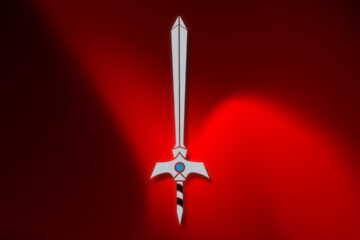THE ABSOLUTE DOCTRINE
The history of the now near-extinct Nasivern race will always remain broken, as far too many pages have been forever torn apart by strife and bloodied by sin, or were outright long forgotten as time went on.
Regardless, there has been a constant element present in many Nasivern tales passed down from generation to generation, even amongst the most ancient ones — words that mention a code that, if you were to chart a timeline, would easily predate modern human history.
This recurring code has at times been referred to as the “Path of Conquest,” the “Soul of the Warrior,” the “Sinner’s Absolution,” and several other names — a discrepancy that can be attributed to the way that the Nasivern language morphed as its people and culture evolved through the centuries, and also attributed to the different perspectives of the scribes of yore.
Thus, whatever its exact original name was has thus been lost in the annals of time.
When the languages of the first Nasivern societies became more unified during the early days of the Nasivern Age of Wonder, this code began to be known by a single name: The Absolute Doctrine.
The Doctrine is one of the most ancient and important Nasivern conceptions, one that was nearly lost through the gruesome wars that decimated most of its population, and further obfuscated by the technological achievements accomplished by the “Heirs of Sin” during times of peace.
At a first glance, the Absolute Doctrine is the culmination of centuries of combat techniques coalesced into one. Nasivern warriors would tell you that the Doctrine is the harmonization of opposites — a conciliation of all of the warring elements within a warrior’s life and soul, and a path to victory, everlasting and absolute.
The Doctrine’s core fighting concept relies on exerting and manipulating the flow of battle to the warrior’s exact needs. Swords, axes, spears, fists, blades, bare fists, the Doctrine encompasses the most complete form of intertwined melee combat teachings ever recorded in history.
It also teaches how to seize your opponent’s emotions, desires, needs, and fears, so that one can turn them into a weapon against your opponents. While it is inherently oriented towards melee combat, several of its concepts can be applied to ranged combat up to a certain degree.
In battle, practitioners of the Absolute Doctrine become the composer and conductor of a symphony of life and death. Each step, each strike of a weapon, must flow in perfect harmony with one another. The warrior’s body and weapon become one, and together with their spirit and soul achieve a balance so sublime that they’re able to make their enemies dance to their own tune — and thus, seize the victory they seek for themselves, painting the portrait of their triumph with the blood of the vanquished.
The Absolute Doctrine isn’t just theatricality and coalescing combat techniques, there is another spiritual aspect of it that goes beyond the field of battle — a way to perceive and shape life itself.
Its tenets establish that no two warriors are similar to one another, that each individual has their own truth to seek and uphold, no matter how righteous or wicked their cause might seem to others, as long as it’s genuine and comes from within.
Each practitioner of the Doctrine must be aware that while they all have different people and things that they love and must fight to protect there will always be someone or something that will seek to destroy that which the warrior cherishes so dearly.
To draw passion from that which they love in order to protect it; to draw the strength to destroy that which opposes it — to reach a harmony within the war that rages within, so that the warrior can achieve the victory required to create their own reality through battle — that is the Absolute Doctrine.
One of the most prolific recorded practitioners of the Absolute Doctrine was the Nasivern warrior known as Isthara, a brave hero who rose up in arms against the Arghest Empire during the Nasivern Age of Devastation.
Daybreak, the band of heroes that Isthara founded and led in life, were also practitioners of the Doctrine. Following the fall of the Empire, and the peaceful rebirth of the Nasivern during their aptly named Age of Rebirth, she followed tradition and imparted the knowledge to her son.
After the fall of Nineveh, it was inferred that what few practitioners of the Doctrine remained fell in battle during the tragic final days of the Nasivern home world. The Absolute Doctrine was considered to be a lost art, even among the few surviving Nasivern, but the appearance of a young crimson warrior might just be the spark that reignites the flames of the Doctrine.
What reality will he carve through wielding the legacy of the warriors that came before him? That question remains to be answered.
Sword of Vaifen is a work in progress. Things are not set in stone and can be subject to change.
Every image, logo, and any other graphics that you see here are placeholders, none of them are final.
2024, by Christian Kaleb Caruzo.


